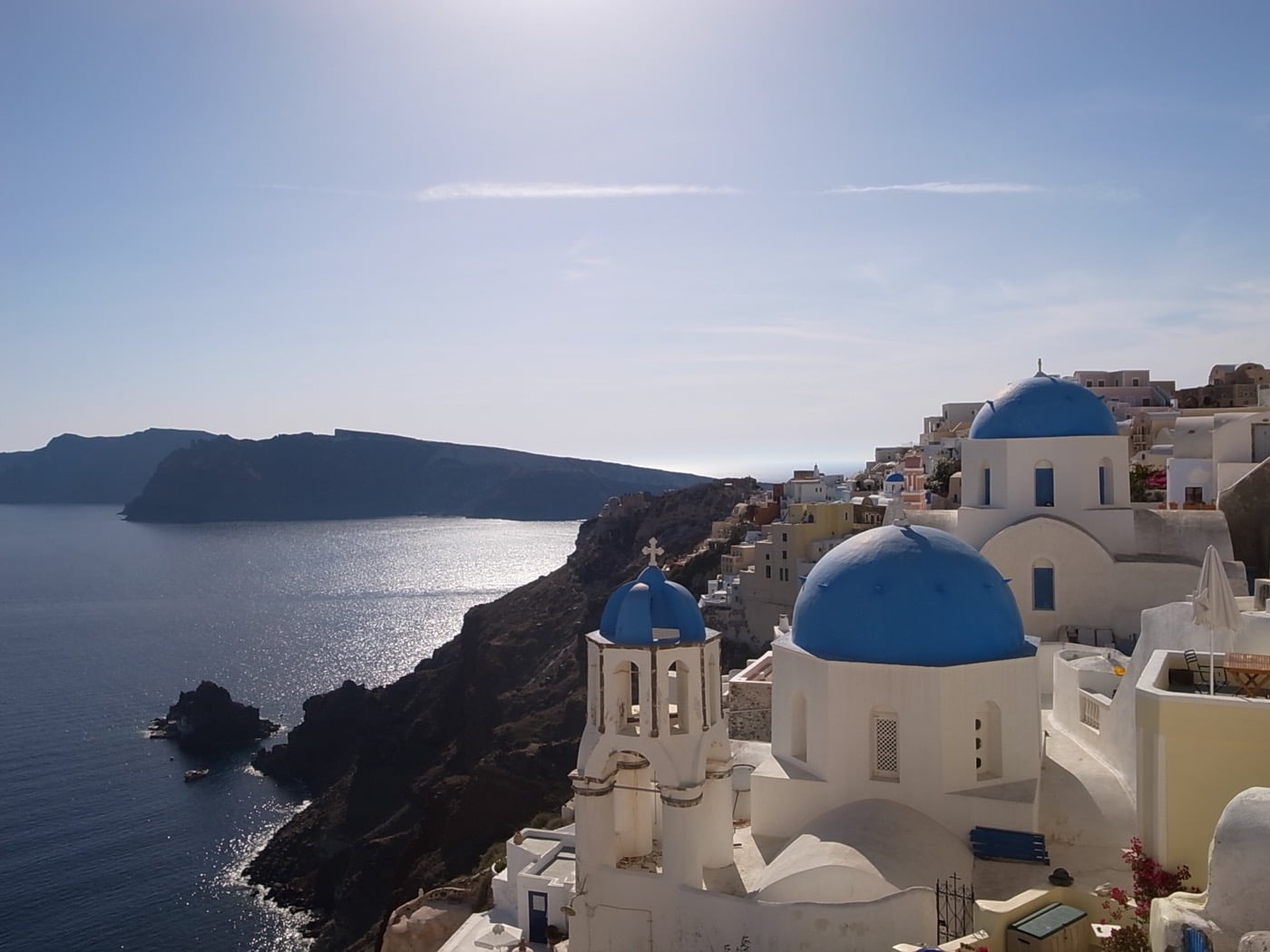It’s been said that the island of Santorini was created by a famous earthquake about 1500 BC and that it may be a remnant of the legendary lost continent of Atlantis. While this is true, there is another side to the mysterious island. Writers throughout history have already dedicated countless words to its infinite beauty and authentic Greek charm but most of us today know Santorini simply as a May to September tourist magnet.
This is a modern history of the alluring island of Santorini, a chronology of how it became an icon for visitors and what it offers – beyond breathtaking sunsets.
The Island
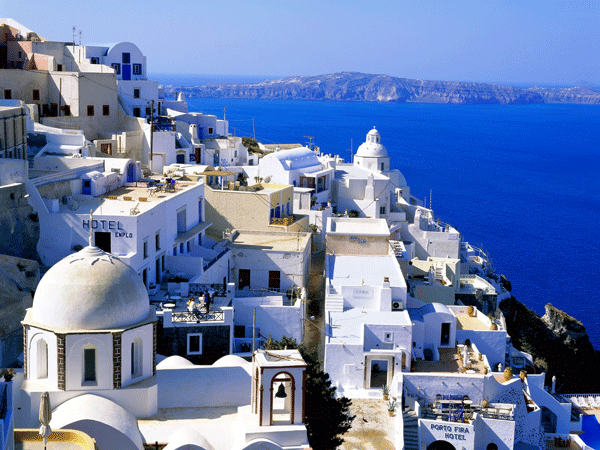
The modern history of Santorini begins in 1956 with a devastating earthquake that severely damaged the island’s infrastructure. Santorini had survived on manufacturing, agriculture, and quarries, but after a period of reconstruction in the 1970’s, it concentrated its efforts on the growing tourism industry, which today remains the largest contribution to the island’s economy. Although winemaking has been a major factor, too, that process was modernized after the 1956 earthquake to the industry that exists today.
The island has so much to offer it might help to familiarize yourself with it by glancing at a map. Shaped like a crescent moon, Santorini is just 11 miles long and only 4 miles wide. Its largest villages are Fira, in the center, and Oia, at the western tip. When in one, you are looking at the other. They both face the Caldera, the crater formed by the 1500 BC earthquake that destroyed the Minoan civilization. The island rests on a shelf due to its volcanic origins, resulting in fertile land perfect for growing wine-quality vines.
Winemaking
Santorini is known for its dry white wine made from Greece’s most noble white grape, Assyrtiko. Also produced is Vinssanto or “Vini di Santorini,” as the Venetians called it in the ancient period. Santorini wines are available in restaurants all over the world and are practically steeped into the peoples’ psyche. Winemaking happens locally through family owned businesses on small lots. It’s not an easy task to produce these wines, as the climate and tough growing environment make it difficult to maintain the vines, yet the industry is vibrant and thriving. Recently, the winemakers of Santorini have begun to make reds, and although their efforts are noble, they are still perfecting their skills.
There is a small production of dry red wines made from interesting varieties, like Mavrotragano and Mandelaria. Mandelaria is grown on other Aegean Islands as well as Santorini.
Gastronomy
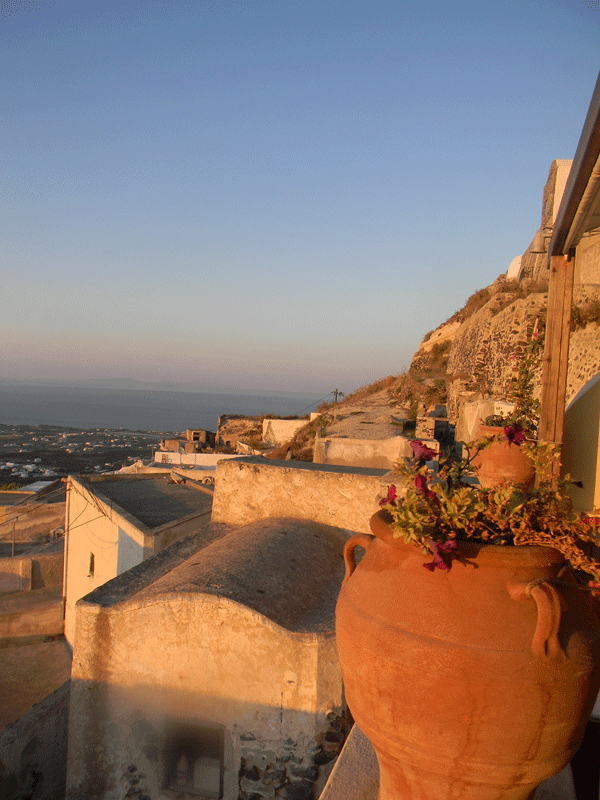
Sanorini is the culinary capital of the Greek Islands. The agricultural roots of the island go back to ancient times, but the cuisine of Santorini today is not only steeped in tradition but is truly modern and unique at the same time. The products you find in the cuisine are grown in the island’s volcanic soil, and with the sea breezes and Mediterranean sun they create sweet flavors that you can’t find elsewhere. True Santorini cuisine is created with the use of four important ingredients that are cultivated on the island: tomatoes, fava puree, white eggplant and capers.
First and most important are the locally grown tomatoes that have been cultivated since 1880 and are a base for many Santorini dishes. They are served morning to evening and you’ll find a tomato bruschetta at breakfast, a salad with tomatoes at lunch, and a tomato keftedes for dinner. The lunch salad with tomatoes intensifies the famous Hortiatiki or Greek salad. The tomato keftedes look like meat balls but on Santorini, instead of meat they are made with the tomatoes and the flavor is very sweet, infused with herbs and butter.
Another ingredient cultivated on the on the island is fava … not the gigantic beans that are commonly seen in the U.S., but a puree of the yellow fava beans. These fava (a yellow split pea) have a special taste and are used in a variety of dishes. They are seen on many plates in Santorini restaurants in place of potatoes.
There are other vegetables farmed and you’ll find them in many of the dishes in the Santorini restaurants like white eggplant, smaller than what is usually seen and capers, which are bigger than what we’re accustomed to.
Santorini’s Beaches
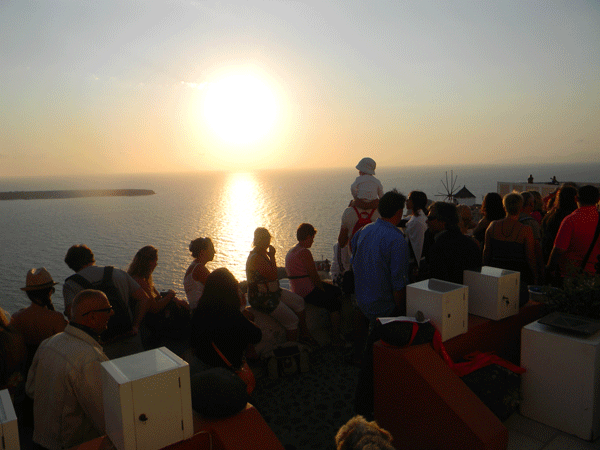
The island itself doesn’t disappoint for breathtaking scenery, however, some say you don’t go to Santorini for the beaches because they are not what you expect to find on a Greek island. I disagree as I found that there was a diversity not found on other islands. You have your choice of black and red sand beaches along with pebble beaches on the island. There are numerous ones including Red Beach, Kamari, Perissa, Agios Georgis, Cape Columbo, Montolithos, Perivolos, Vivchada, Vourvoulas, and White Beach.
The best are:
Located near the ancient ruins of Akrotiri (the Pompeii of the Aegean), the Red Beach is the most famous. It is a breathtaking setting, where soaring red lava cliffs emerge from the black sandy shore and mesh with the crystal blue sea. Many tourists come to this beach just to see the natural beauty without even catching a ray of sun or a swim.
Perivolos Beach is one of the most famous black sand beaches on the island. Located near the town of Perissa, it’s also one of the liveliest. There are numerous tavernas on the beach road with beach clubs on the sand, one more impressive than the next, where you can see the trendiest people visiting the island. While also stunningly beautiful, this is a commercial beach where you’re able to have some of the best service. Some refer to Perivolos as an extension of Agios Georgis since the two beaches are contiguous.
Kamari is a famous beach resort that is situated about 6 miles southeast of Fira. It has an impressive long and inviting black sand beach, illustrated by an enormous rock called Mesa Vouno that rises out of the sea. Kamari has a great landscape, especially at night when the rock is lit.
The Villages
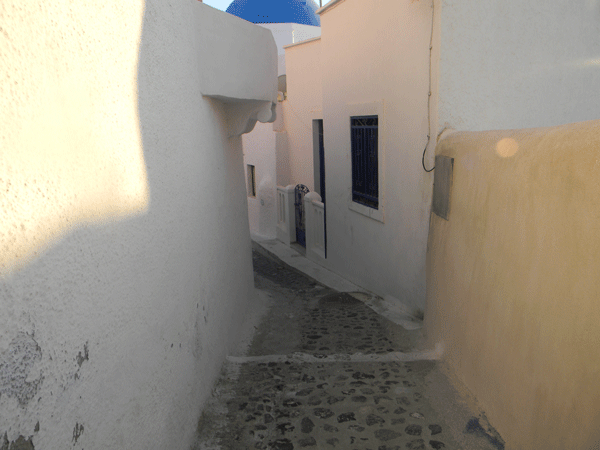
Don’t go to Santorini and visit only Fira and Oia, the largest and most well-known villages on the island. There are many other fantastic villages worth exploring including Emporio, Finikia, Firostefani, Messaria, Pygos, and Imerovighli. Each has something to offer that tempt the tourist’s eye.
Pyrgos, which means castle in Greek, is so named because of the Venetian castle, ancient houses and Byzantine church all located in this village. You enter at the bottom of the village which is built on a hill and ascend to it. Narrow, winding alleys lead to the top where you can enjoy an Ouzo or Vinssanto over sunset.
Imerovigli is perched on the rim of the Caldera and as the highest point on the island offers outstanding views. This village was conquered by the Venetians during the 13th Century and today is filled with restaurants and cafes for visitors. The medieval castle of Skaros can also be found here.
Megalahori is located in the interior. In Greek the name means “big village”, but it is actually quite small. It has cobblestone streets and the houses are whitewashed in traditional Cyclades style. Due to its central location you can see the vineyards from here.
Emporio is actually the largest village on the island. It is a beautiful medieval village that is surrounded by a barricaded wall.
Santorini goes well beyond the amazing view and has something for everyone – sun, wine, cuisine AND history. Don’t even get me started on the shopping!
From the TravelSquire editorial staff:
For anyone planning a trip to one or more of the Greek islands, it might be helpful to use a full-service tour operator who will arrange itineraries and transportation between them as well as provide knowledgeable guides. KANΩN is an excellent one that offers 3, 4 and 7 day cruises around the Aegean including some of the Cyclades islands. They can also organize tailor-made tours for groups and individuals. KANΩN Cultural Tours & Expeditions, P.P. Germanou 22, Thessaloniki, Greece; 30-2310-237 066 or 30-2310-274-045; www.kanon.gr
[alert type=white]
The country code for Greece is 30.
Where to Stay:
Aressana Hotel – An amazing location just outside the center of Fira and a staff that is friendly and accommodating. The breakfast buffet of local products including cheeses, tomatoes and eggs is one of the best and the guest rooms are simple and contemporary. Serving a farm to table lunch daily, the pool area offers an alternative to the beaches. Fira, 84700; 22860 23900; www.aressana.gr
Nefeles Luxury Suites – if you want to be in the middle of the action yet still be coddled, this is your place. An undulating lap pool leads you into the very private coved entrance where elegantly furnished accommodations await. Fira, 84700, Hellas; 22860 28555; www.nefeles.gr
Katikies Hotel – One of the most photographed hotels on the island. Perched on a hill overlooking the sea with breathtaking views of the Caldera. The rooms are cottages built into the Caldera and some have private terraces. Oia 84702, 22860 71401 www.katikies.com
Vedema Hotel – 45 suites and villas in townhouses scattered about a 15th century winery. Graced with bougainvillea vines, the townhouses are clustered around courtyards and connected by winding lava rock walkways. Megalochori, 22860 81796
Where to Eat:
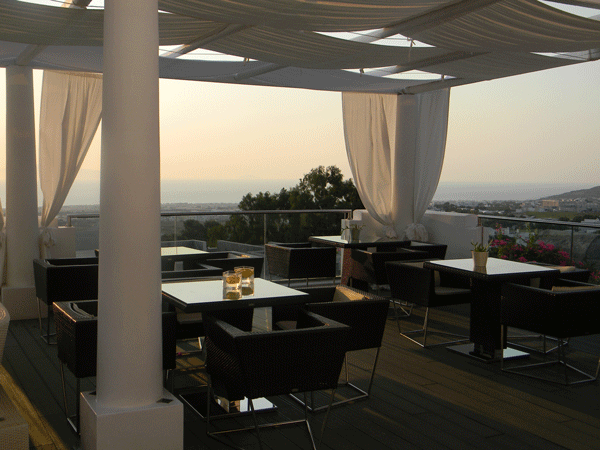
Argo – Open all day and well into the evening, Argo’s prime location at the top of Fira overlooking all of Santorini is dazzling. With four levels serving true Santorinian cuisine with a twist on the traditional, let Konstantin, the gregarious owner, choose a memorable meal. A great place to linger long over many bottles of Santorini wine. Fira 84700; 22860 22594; www.argorestaurant.com
Koukoumavlos – Housed in an original 18th century sea captain’s house, the interior of the restaurant offers a refined romantic setting in a quiet corner of Fira. The highly creative cuisine is created by chef and owner Nikos Pouliasis. Fira, 84700, 22860 23807, www.koukoumavlos.eu
Assyrtiko – Four pillared arches, reminiscent of Tara, lead you up the stairs to the cozy open air terrace overlooking all of Fira. Food here is refined and carefully dedicated to the flavors of the island. Try Chef Yannis’ Santorinian risotto and the spring rolls with pumpkin sauce and let Manolis choose the excellent wines. Fira, 84700; 22860 22463; www.asirtiko.gr
Sphinx – Chef and owner George Psychas offers a relaxing environment to enjoy his Mediterranean cuisine with fresh fish specialties. Odos Mitropoleos, Fira, 84700; 22860 23823, www.sphinx.gr
Selene – Located in Pyrgos, the medieval village, this restaurant just celebrated its 25th anniversary on the island. Preparing a creative menu with products that are found locally, it also offers a large wine list and cooking classes. Pyrgos P.B. 87, 84700; 22860 22249; www.selene.gr
Vinsanto – Housed in a former 19th century winery, it’s a world away from anything else on the island. The menu offers 3 set options, simple and fresh with key island ingredients in each. Glasses of local Santorinian wine are also paired. Megalochori, 84700, 22860 81796, www.vedema.gr/en/vinsanto
Skala – View the endless horizon of Santorini from this fish taverna in Oia, just steps away from Oia’s central square. Perfect for innovative Greek cuisine like an onion and pine nut pie and the special Skala salad. Oia, 84700; 22860 71362; www.travel-to-santorini.com/restaurants/oia/skala
Where to Drink:
Azur Lounge – Can’t get enough of the overpowering beauty of Santorini’s sunset? Grab a power spot along the front railing here and lock it in. Fira, 84700; 22860 23560
Kasteli – When you’re aching to see the sun set somewhere else besides Fira, this is the spot. Perched at the highest point of Pyrgos, it’s serene and romantic. Pyrgos, 6978 752 079
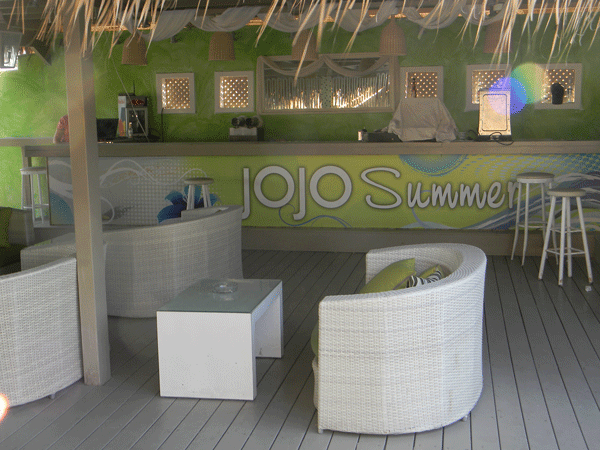
JoJo Beach Bar – Just about the hottest and the coolest beach club on Perivolos Beach. Good food, pumping music by in-house dj’s and an all around fabulous atmosphere. Nice beach to swim, too. www.facebook.com/pages/JoJo-Beach-Bar-Santorini/151178608292400
Where to Shop:
Spicy – Don’t even think about strolling the whitewashed alleys of Santorini after dark without some designer duds. This shop’s got the best of them. Fira, 84700; 22860 21557; www.spicy-shop.com
Goulas Ceramic Art Studio – Climb to the top of Fira and award yourself with a visit to the amazing studio of Andreas Alefragis. Take home an original, just close your eyes and point. They are all works of art. Firostefani, 84700; 22860 24750
[/alert]

